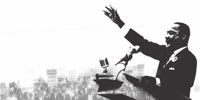Posted on January 11, 2022

By Paul Vanguard, for BullionMax.com
Dr. Martin Luther King, Jr. was a man who defined an era. One of only 21 Americans to win the Nobel Peace Prize, a man who spoke truth to power regardless of the cost. He courageously sided with the disenfranchised, the despised and the overlooked over and over again during his thirteen years of civil rights activism.
We would all like to think we have the same kind of grit and determination as Dr. King. That if we saw the racial injustice of the American South in the late 50s, we’d rouse ourselves to take action. Honestly, though, how many of us would persevere if our homes were bombed? If we were stabbed in the chest? If the FBI tapped our phones and blackmailed us? (And those are just the highlights.)
Dr. King overcame those challenges and more. He persistent and he changed the world, one state at a time, one speech at a time.
One of the fun things about coin collecting is, you can create your own theme to organize your collection around. Today, I’m offering you a preview of my personal Dr. King Commemorative Coin Collection.
(Don’t take this the wrong way; I’m not trying to diminish Dr. King’s achievements, or make myself out to be some numismatic ninja. I just want to show you how to combine two things you’re passionate about into one new thing.)
 I Have a Dream
I Have a DreamI have a dream that my four little children will one day live in a nation where they will not be judged by the color of their skin but by the content of their character.
America the Beautiful: Frederick Douglass
You simply cannot argue that this coin fits right in with Dr. King’s beliefs. The Washington, D.C. edition of the America the Beautiful coins honors Frederick Douglass, a famed American abolitionist, social reformer, orator, statesman, and writer. Also known as the most influential African American of the 1800s. He believed uncompromisingly in the equality of all people, regardless of race, gender, or nationality. When criticized for that view by radical abolitionists because of his his willingness to negotiate with slave owners, he famously replied: “I would unite with anybody to do right and with nobody to do wrong.” Is there any sentiment Dr. King could approve more strongly?
 Our God is Marching On
Our God is Marching OnHow long? Not long, because no lie can live forever. How long? Not long, you shall reap what you sow.
America the Beautiful: Tuskegee Airmen
Honors the Tuskegee Airmen National Historic Site. All African-American military pilots (from the U.S. and Haiti and Trinidad and the Dominican Republic) who fought in World War II were trained here. The phrase “Tuskegee Airmen” refers most often to the 99th Pursuit Squadron, who served with great distinction across the European theater. Despite this, Black Americans were still subject to Jim Crow laws during World War II and faced discrimination both in the armed forces and in the U.S.
To remind us of this injustice, the reverse of the coin baldly states, “THEY FOUGHT TWO WARS.” Not World War II and Korea, no: prejudice and discrimination as warriors and as civilians.
 The Three Evils of Society
The Three Evils of Society...there're times when you must take a stand that is neither safe nor politic nor popular, but you must do it because it is right.
America the Beautiful: Cumberland Island
At first glance, there’s absolutely zero connection here. Here’s what you probably don’t know: Cumberland Island is an ecologically unique location. There are at least 23 distinct ecological communities making this the most diverse barrier island in America. It’s not just diverse in flora and fauna, though. This is a historic place, too. The park hosts a mansion built by the Carnegie family in the 1890s as well as the First African Baptist Church, built by African Americans who’d been born into slavery and freed by the American Civil War. In the words of the National Park Service website, “Natives, missionaries, enslaved African Americans and wealthy Industrialists all walked here.”
 I’ve Been to the Mountaintop
I’ve Been to the MountaintopI'm happy tonight. I'm not worried about anything. I'm not fearing any man. My eyes have seen the glory of the coming of the Lord.
America the Beautiful: Great Smoky Mountains
Once again, you’re thinking, “What’s the connection?” Let me tell you: the Great Smokies, those remarkably ancient landscapes so full of life, were once the home of the Cherokee tribe of Native Americans. First the British, and later newly-minted Americans coveted this land. The Cherokee were evicted in 1838, forcibly relocated west during a migration known to history as The Trail of Tears. This coin reminds me that so often in our land, a beautiful landscape conceals a bloody backstory.
 Freedom Sunday
Freedom Sunday
Let us, therefore, resolve to be engaged in a sort of divine dissatisfaction until the American dream is a reality.
Far from the high-rises and winding rails of the L train, you’ll find Shawnee National Forest’s Garden of the Gods. Camel Rock, featured on the coin’s reverse, is just one of its many geologic wonders. It’s another curious juxtaposition, isn’t it? Segregated housing and protests against racial injustice on the one hand, stark natural beauty on the other? In my mind, here’s the connection: It’s a reminder of just how ugly, and how beautiful, America can be at the same time.
This is one way I honor Dr. King's legacy. What's yours?
Paul Vanguard is a lifelong precious metals enthusiast and a proud member of the BullionMax team.